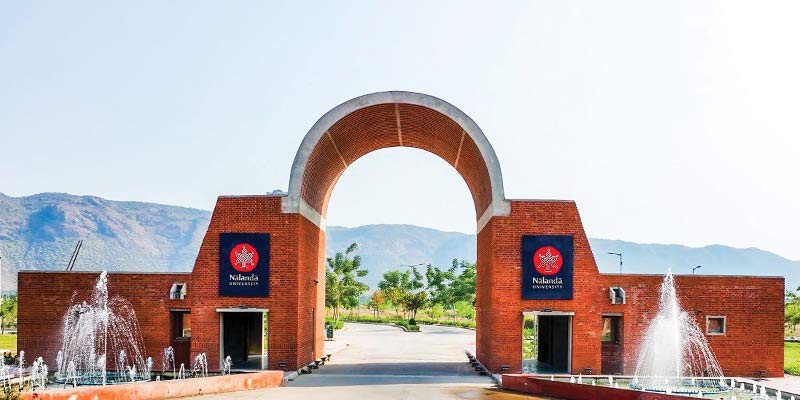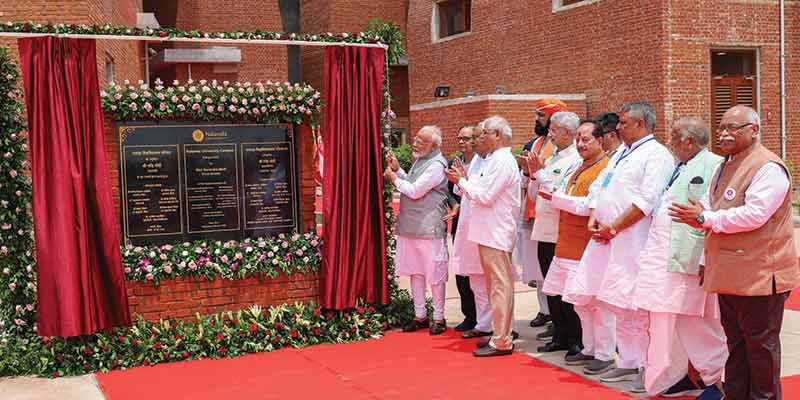- India
- Jun 19
- Kevin Savio Antony
PM Modi inaugurates new campus of Nalanda University in Bihar’s Rajgir
• Prime Minister Narendra Modi inaugurated the new campus of Nalanda University at Rajgir in Bihar.
• Before inaugurating the new campus, Modi visited the ‘Nalanda Mahavihara’, a UNESCO World Heritage Site located close to the varsity.
• The educational institute was established through the Nalanda University Act in 2010 and it started functioning in 2014.
• The ancient Nalanda University, which existed since the fifth century, attracted students from all over the world. It flourished for 700 years before being destroyed by invaders in the 12th century.
Establishment of new campus
• The new university started functioning in 2014 from a makeshift location with 14 students.
• Construction work on the university started in 2017.
• The university has participation from 17 other nations apart from India — Australia, Bangladesh, Bhutan, Brunei Darussalam, Cambodia, China, Indonesia, Laos, Mauritius, Myanmar, New Zealand, Portugal, Singapore, South Korea, Sri Lanka, Thailand, and Vietnam. These countries have signed MoUs in support of the university.
• The university offers 137 scholarships to international students.
Architecture of the University
• Architectural Inspiration: The administrative block or Wing-1 building at the university replicates the iconic exposed brick architecture of the Nalanda ruins, featuring the VC’s office and other administrative offices.
• Passive Heating System: The main wall of the University comprises two parallel walls with a cavity between them, designed to trap heat effectively. Additionally, plans are in place to utilise heat emitted from air-conditioners to generate warm water for bathroom use.
• Academic Spine Design: The academic spine will host all schools and study centers in open rooms reminiscent of the student cells at Nalanda Mahavihara. These spaces are intended to serve as study areas for students.
• Central Campus Features: At the heart of the campus, the Kamal Sagar (lotus pond) will be surrounded by a chain of arcades or “bottle-shaped bazaars”. These arcades will offer students a variety of amenities, ranging from stationery to snacks, creating a vibrant hub within the university campus.
Nalanda University
• Historical Background: Nalanda University was founded in the early fifth century AD by Kumaragupta, a ruler of the Gupta dynasty, located in present-day Bihar.
• Established during the Gupta dynasty, Nalanda University thrived for seven centuries, becoming renowned during the reigns of Harshavardhana and the Pala monarchs.
• Nalanda University is renowned as one of the earliest great universities in recorded history.
• Monastic Origins: Situated in the ancient kingdom of Magadha, modern-day Bihar, Nalanda served as a prominent Buddhist monastery.
• Academic Focus: While Nalanda offered teachings across all Buddhist sects, Mahayana Buddhism was the primary focus. The curriculum also included secular disciplines such as grammar, logic, epistemology, and science.
• Campus and Facilities: The university boasted ten temples, meditation centers, and housed the world’s largest library, divided into three buildings: Ratnasagara, Ratnadadhi, and Ratnaranjaka. This library held religious manuscripts and an extensive collection of books covering literature, astrology, philosophy, science, and warfare.
• Renowned Scholars: Notable scholars associated with Nalanda include Nagarjuna (Madhyamika Shunyavad) and Aryabhatta, the astronomer.
• Intellectual Exchange: Nalanda was a hub of scholarly debates and discussions. King Harsha reputedly invited a thousand educated monks from Nalanda to a philosophical assembly in Kanauj.
• Chinese Scholars: Chinese traveller Hiuen Tsang visited Nalanda during King Harsha’s reign, attending the university for two years. Another Chinese scholar, I-Tsing, noted that Nalanda accommodated 2,000 students and was financially supported by contributions from 200 villages.
• International Influence: The university attracted students from China, Mongolia, Tibet, Korea, and other Asian countries, fostering cultural and intellectual exchange.
• Destruction: The university’s prominence continued until its destruction in 1193 AD by Bakhtiyar Khilji, a general of Turkish ruler Qutbuddin Aibak, marking the end of its era as a center of intellectual activity.
• Revival Efforts: In 2010, the government of India initiated efforts to revive the legacy of Nalanda University. A modern institute, also named Nalanda University, was subsequently established in Rajgir.
• National Importance: Recognised by the Indian government as an ‘Institute of National Importance’, the contemporary Nalanda University aims to carry forward the ethos of its ancient predecessor in the realm of higher education and intellectual pursuit.
• Archaeological Discoveries: Excavations beginning in 1915 revealed 11 monasteries and six brick temples arranged over 12 hectares (30 acres). The site yielded a wealth of artifacts, including sculptures, coins, seals, and inscriptions, now housed in the Nalanda Archaeological Museum nearby.
(The author is a trainer for Civil Services aspirants.)


